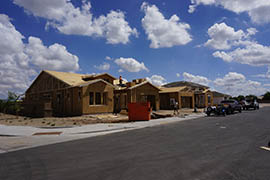Cronkite News has moved to a new home at cronkitenews.azpbs.org. Use this site to search archives from 2011 to May 2015. You can search the new site for current stories.
Study finds Phoenix-area home starts down through third quarter
PHOENIX – Phoenix-area home builders are heading for a disappointing end to the year, according to a survey that shows a decline in home starts.
According to a third quarter report released by Metrostudy, a housing market consulting company, new home starts were down 10 percent during the 12 months ending Sept. 30 compared to the previous 12 months.
The largest drop was in the struggling market of Pinal County with 23 percent. The high-end northeast Valley, however, has continued to see an increase with 37.5 percent.
Rachel Cantor, regional director of Metrostudy, said many factors may have contributed to the decline, which departed from the 30 percent growth her organization has predicted for the year.
“We didn’t see the job increases we needed, mortgages became tighter,” she said. “And that’s definitely hurt builders in Phoenix because they counted on that mortgage market.”
Millenials who are holding out on buying homes could also be contributing to the lower numbers, Cantor said.
“They’ve been on the fence the whole year,” she said. “They have not been forming households, they’ve been living with their parents much longer … they’ve gotten jobs but they haven’t gotten real high-paying, jobs so their debt has kind of been a burden to them.”
Michael Orr, director of Arizona State University’s Center for Real Estate Theory and Practice, said the survey’s results aren’t dramatic but are a little surprising.
“It looks like we’ll actually sell fewer new homes this year than last year, which nobody predicted,” he said. “And I was probably the least optimistic, but even I thought there would be a slight increase.”
Walt Danley, owner of Walt Danley Realty, which specializes in resale homes in the northeast Valley, said that buyers could be finding better value in resale homes.
“A lot of people are more conscious than ever about wanting to be a little closer to where they work,” he said. “They’re not interested in a 45-minute, hour-long commute, so there’s a bigger demand for housing that’s a little closer to work (and) play, and that typically ends up being resale houses because of a lack of land in the interior parts of the city.”
The survey also showed that the overall inventory of vacant developed lots rose a minor 5 percent in the third quarter compared to the same quarter a year ago. Many of these lots are located in Pinal County and the southwest Valley, which are located in the outlying areas of the city and tend to be less desirable places to live for buyers.
Cantor said that these numbers are expected to carry through to the end of the year, and she said builders should set their expectations accordingly into 2015.
“Be more realistic, set some expectations for yourself, don’t expect 15 to 20 percent growth,” she said. “If you’re going to grow, you’re going to have to figure out how to take market share from other builders versus the market actually growing.”







